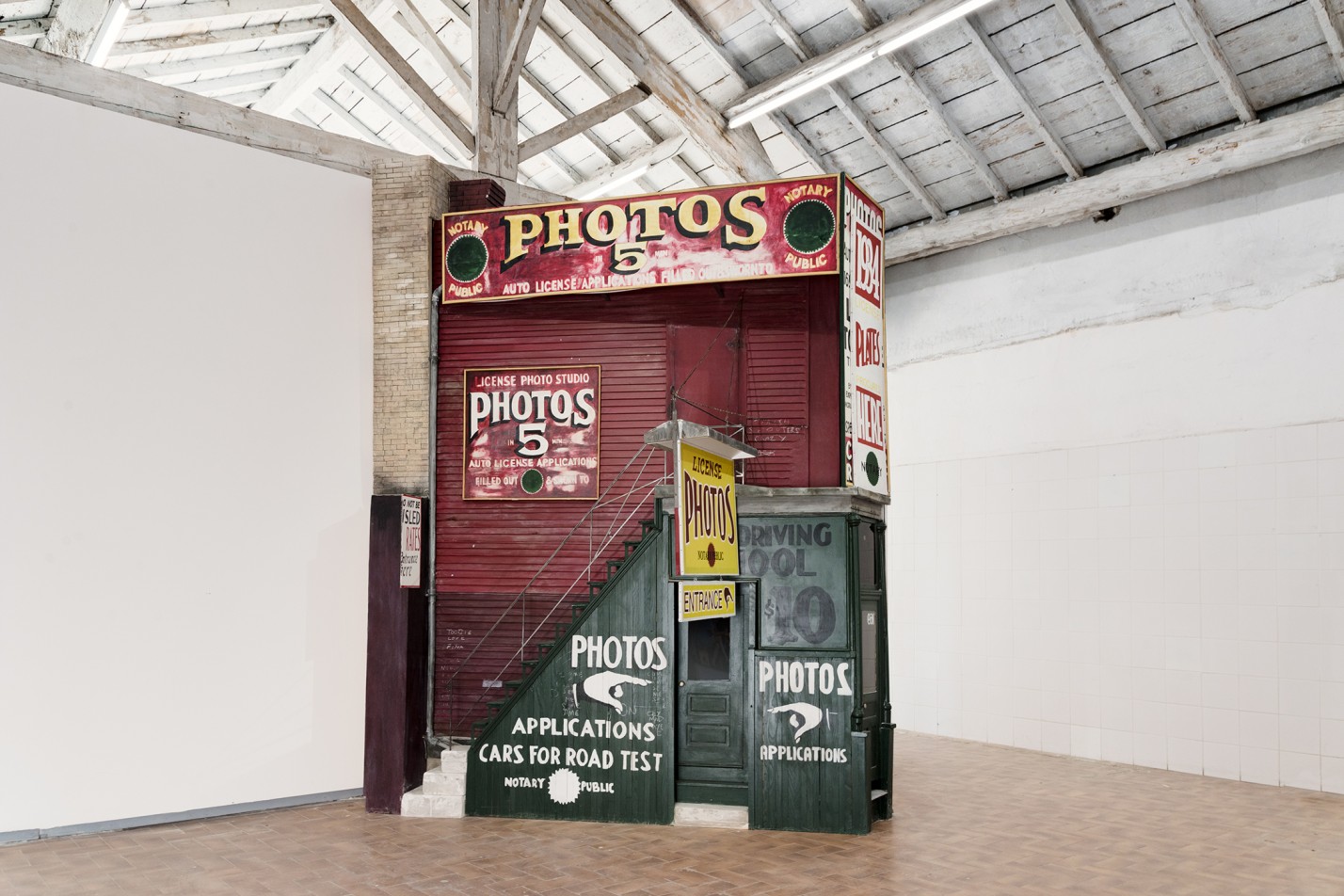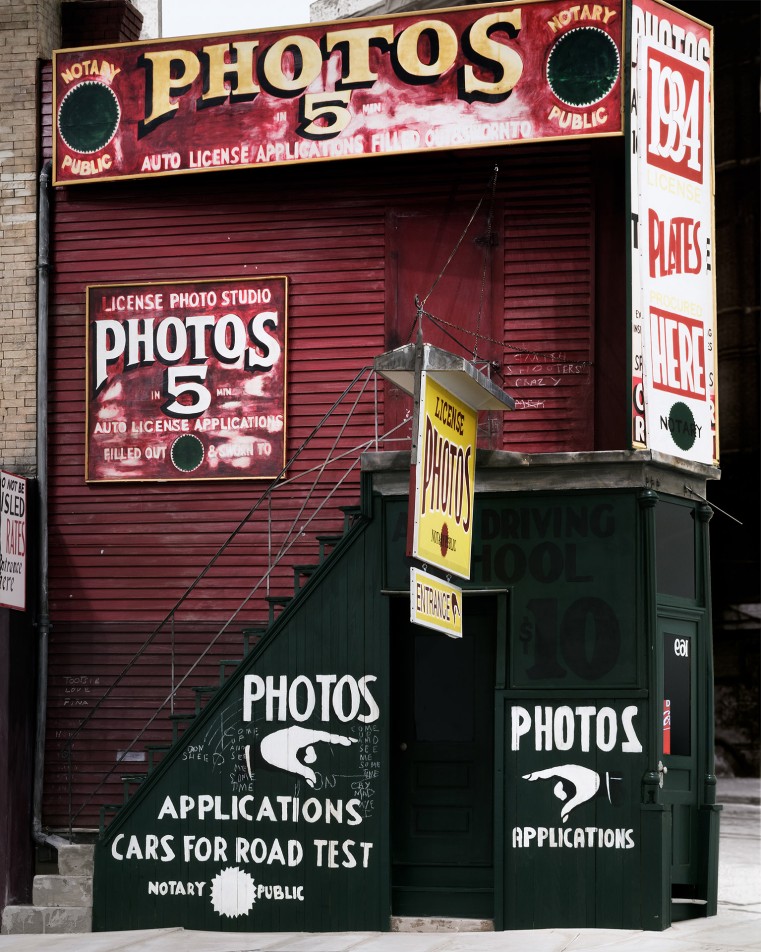Camille Fallet
License Color Photo Studio
La qualité d’une œuvre documentaire tient à l’expression de l’expérience qui la fonde, au montage et à l’écriture qui la rendent sensible. La photographie, pour Camille Fallet, n’a d’intérêt qu’à travers son édition et, pour reprendre les termes de Walker Evans, son élaboration en « documentaire lyrique ».
En 2016 à la Straat Galerie à Marseille, Camille Fallet a recréé une maquette à l’échelle 1/2 d’un magasin de portraits photographiques à cinq cents, tirée d’une image de Walker Evans : License Photo Studio, New York, 1934. C’est en étudiant très précisément l’image d’Evans qu’il a conçu, non sans difficulté et incertitude, cette maquette. De la même manière, le travail de tireur qu’exerça Camille Fallet consiste à essayer de traduire une situation qu’il n’a pas vécue ; il doit la fantasmer, en faire sa propre expérience. Les formes ainsi produites réactivent souvent des modèles photographiques ou des œuvres d’artistes reconnus, qui se superposent et s’enchevêtrent. Ainsi, la maquette reproduisant la photographie d’Evans s’avèrait également fonctionner comme une reprise d’Étant donnés (1946-1966) de Marcel Duchamp.
En 2018, l’artiste a remonté cette maquette au centre d’art du Point du Jour à Cherbourg pour la photographier telle que Walker Evans avait photographié le magasin de portraits photographiques en 1934. L’image ainsi produite fait jouer différentes équivalences et transpositions : l’image noir et blanc d’un magasin reconstruit en volume et en couleurs ; la maquette d’un studio de prise de vue photographiée comme en studio ; un studio qui est le lieu dans lequel la photographie est exposée…
Pour Camille Fallet, si Walker Evans est la figure de la modernité en photographie, c’est bien plus par la posture « anti-art » qu’il affirme, et les questions qu’elle suscite, que par sa valeur désormais iconique. En en faisant son modèle, Camille Fallet cherche d’abord à ouvrir et à déconstruire la photographie comme reproduction, à questionner sa relation au volume et à la perspective, son émancipation possible de la question de la vraisemblance pour poser celle du lyrisme en photographie. Il s’agit ici de la possibilité d’exercer son propre regard en s’appropriant une histoire et, pourquoi pas, en la réinventant.
Cette œuvre, récemment acquise par le Fonds régionale d’art contemporain de Provence-Alpes-Côte d’Azur est présentée ici dans une nouvelle version.
The quality of a documentary work lies in the expression of the experience on which it is based, and in the editing and writing that make it sensitive. For Camille Fallet, photography is only of interest through its editing and, in the words of Walker Evans, its development into a ‘lyrical documentary’.
In 2016 at the Straat Galerie in Marseille, Camille Fallet recreated a 1/2-scale model of a five-cent photographic portrait shop, taken from an image by Walker Evans: License Photo Studio, New York, 1934. It was by studying Evans’ image in great detail that he designed this model, not without difficulty and uncertainty. In the same way, Camille Fallet’s work as a photographer consists of trying to translate a situation that he has not experienced; he has to fantasise about it, experience it for himself. The forms thus produced often reactivate photographic models or works by well-known artists, which are superimposed and intertwined. For example, the model reproducing Evans’ photograph also functioned as a reworking of Marcel Duchamp’s Étant donnés (1946-1966).
In 2018, the artist reassembled the model at the Point du Jour art centre in Cherbourg and photographed it as Walker Evans had photographed the photographic portrait shop in 1934. The resulting image plays on different equivalences and transpositions: the black-and-white image of a shop reconstructed in volume and colour; the model of a photographic studio photographed as if in a studio; a studio that is the place in which the photograph is exhibited...
For Camille Fallet, if Walker Evans is the figure of modernity in photography, it is much more because of the ‘anti-art’ stance he asserts, and the questions it raises, than because of his now iconic value. By making it his model, Camille Fallet is seeking first and foremost to open up and deconstruct photography as reproduction, to question its relationship to volume and perspective, and its possible emancipation from the question of verisimilitude in order to raise the question of lyricism in photography. It’s about the possibility of exercising one’s own gaze by appropriating a story and, why not, reinventing it.

